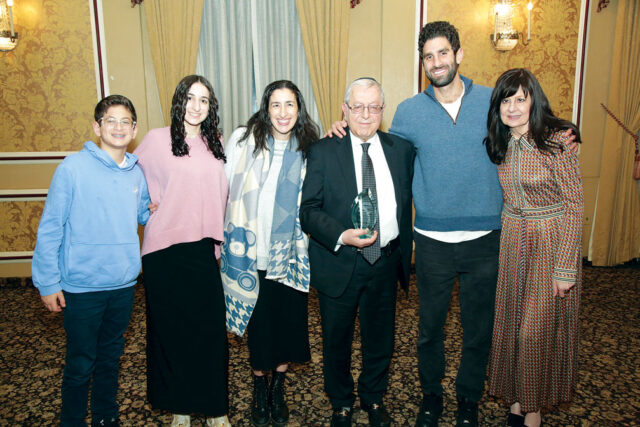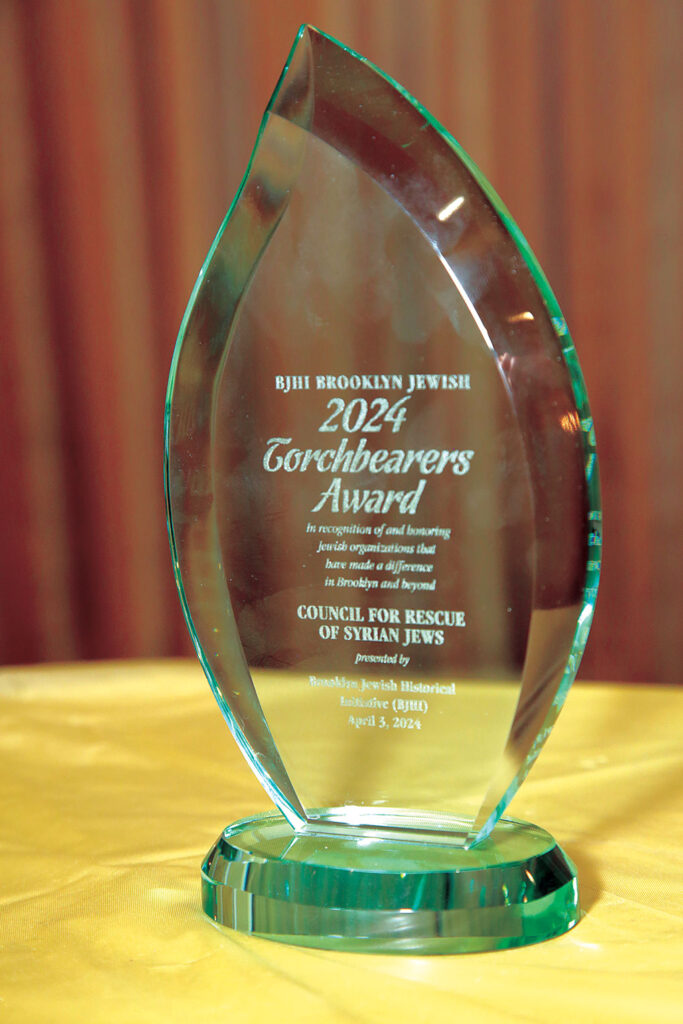
ON BEHALF OF COUNCIL FOR THE RESCUE OF SYRIAN JEWS
SARINA ROFFÉ
Dr. Mayer Ballas was lucky enough to leave Syria legally in 1978. He wanted to leave to escape oppression and because he wanted to get into a specialty medical program. It took two years for him to get permission to leave with the help of Congressman Steve Solarz and community member Steven Shalom.
When he arrived in New York he was alone. He realized that not many people in our community knew what his fellow Syrians were living through, so he started by giving speeches in Shaare Zion and other synagogues.
Background
Even before the creation of Israel, Syrian Jews began suffering persecution. It began with pogroms in 1947. They were virtually prisoners, unable to hold government jobs, or travel more than a few kilometers from their homes without permission. Their businesses were boycotted, and they became easy targets for Muslims. Their identification cards were stamped Musawi — Jew — and they could not travel as a family on vacation. If one person were to travel, they had to provide bond. If they didn’t return, the bond was forfeited and the rest of the family jailed and tortured.

They were not allowed to teach their children Torah; a Muslim principal was assigned to their schools. Women were raped. In 1965, Eli Cohen, the Israeli spy who infiltrated the Syrian government, was caught and hung. Over the course of several decades, many Syrian Jews escaped using smugglers and people outside of Syria to get them across the border into Turkey or Lebanon and from there, they went to Israel, New York, or Mexico.
During a time when the world was focused on the issue of Soviet Jewry, little attention was paid to the plight of Syrian Jews. But virtually every Jewish agency knew and had reports in its archives about the terrible difficulties of Syrian Jews.
In Brooklyn, Isaac Shalom raised money annually for the Near East Jewish Aid Society and worked with the Joint Distribution Committee (JDC) to send funds to Syria.
In the 1970s, there was the Committee for the Rescue of Syrian Jews, operated by Abe Dwek, another Syrian emigree. Dwek had letter writing campaigns, organized demonstrations and did lobbying. At every rally for Soviet Jews, Dwek and yeshivah students held banners to Free Syrian Jews, documented on the front page of the New York Times on April 29, 1974.
Over the course of some 40-plus years, the JDC sent more than $10 million to help the communities in Aleppo, Damascus and Qamishli. There were also people outside of Syria who helped get escapees to safety — Shula Cohen aka the Pearl, Albert Elia and the Jewish community of Beirut, the Shamosh family in Iskenderun, and Judy Feld-Carr in Toronto, aka the Rescuer.

Council for the Rescue of Syrian Jews
After hearing talks from Dr. Ballas and other Syrian Jews, such as Abe Dwek, Maurice Hedaya A”H encouraged Ezra Ashkenazi and Ricky Cohen to start a committee. There was a meeting during a Guindi wedding at Shaare Zion. Judy Feld-Carr was there. Ezra and Ricky were young adults at the time, but they were energized to help and started Save Our Syrian Jews.
In 1989, the name was changed to The Council for The Rescue of Syrian Jews and Dr. Ballas became the first president. He was so dedicated to the mission of freeing his fellow Syrian Jews that he took years away from his practice to work with the Council. The Council was organized to work on getting the remaining 4,500 Jews out of Syria through legal means. There were lobbying efforts and heavy pressure put on consulates around the world.
Janet Zalta and Albert Harary were involved. Jack Mann, Albert Ayal and Clement Soffer were vice presidents. Marcos Zalta was the second president and Alice Sardell was the third president. Gil Kahn, their executive director, had strong ties on Capitol Hill. All of them made herculean efforts to free the Jews remaining in Syria. Dr. Ballas personally met with President George Bush to put the issue of Jews from Arab lands on the table.
During that point in history, the issue of Soviet Jews was at the forefront. The Soviet Union fell apart and no longer was backing Syria. President Assad needed funds and turned to the Americans. It became a political game. During every conversation Assad had with the United States, the issue of freeing the Syrian Jews came up.
The Council brought up the issue of Syrian Jews to every congressman and senator. They met with consuls from many countries. They held rallies. They appealed on humanitarian grounds. They explained that families were separated and should be reunited. They got a resolution passed in Congress.
The Final Exodus
In April 1992, just before Passover, Syrian President Hafez Assad agreed to let the Jews legally leave as families. This was the work of the Council. Assad met with leaders of the community in Damascus and announced he would allow the Jews to leave — an Exodus if you will. About 3,000 people got out during the next five months. The Safra Foundation provided funds for airplane tickets for those who couldn’t afford them. Syria required round trip ticket purchases. When people got to New York, the Council returned the return ticket and got refunds to buy tickets for other new arrivals.
Then, in November 1992, Assad slammed the doors shut again because there was a presidential election. It took until 1994 for the doors of emigration to open again and allow the remaining 1,500 Jews to leave.
Settlement
Scores of people were coming on planes from Syria each week. Each of them needed a place to live, close to the community where they could find kosher food and be within walking distance from a synagogue. Plus, over 900 children needed to be placed in Jewish schools. Sephardic Bikur Holim became the hub for all activities. The United Jewish Appeal raised $30 million to help with resettlement of the new arrivals.
Scores of volunteers helped them find apartments, shop for bedding and kitchen supplies, and obtain furniture. Many of the children arrived in the late spring and summer, so they were given English classes taught by volunteer teachers from Ahi Ezer Yeshiva during summer camp to prepare them for school in September.
The New York Association for New Americans (NYANA) organized English classes. They also helped identify jobs for the new arrivals. The Hebrew Immigrant Aid Society (HIAS) helped with visas and the massive paperwork to get the new arrivals benefits.

The children needed medical exams and vaccines to get into school. Community doctors volunteered to examine the children and do the paperwork for them to go to school. In one day over 400 children were examined.
There were many cultural issues to overcome. For example, the adolescents did not understand why they had to go to school as it was not required to go to school in Syria after age 13. They wanted to work, but American law required them to attend school, and parents were unaccustomed to paying tuition for yeshivah.
Dr. Ballas made a herculean effort to get over 900 children into yeshivot. He called it the sprinkling system. He found a few seats in each classroom, and placed children in those classes. A temporary school was set up on Ocean Parkway for two years. Girls were placed in Ashkenazi yeshivot that opened their doors to the new arrivals.
The Sephardic Education Fund was set up to raise funds for tuition. It was headed by David Hidary and raised $1.6 million dollars from community donors, the Safra Foundation and other financial institutions. Judy Feld-Carr sent funds for some children from the Feld Fund in Toronto.
It has been 30 years since the work of The Council for The Rescue of Syrian Jews. Countless families were freed from persecution and the tyranny of the Assad regime. BJHI (Brooklyn Jewish Historical Initiative) was honored to recognize its work with the 2024 BJHI Torchbearers Award and give Dr. Ballas and the Council much deserved credit.
A genealogist and historian, Sarina Roffé is the author of Branching Out from Sepharad (Sephardic Heritage Project, 2017). She is researching a new book: Syria – Paths to Freedom. Sarina holds a BA in Journalism, and MA in Jewish Studies and an MBA.



